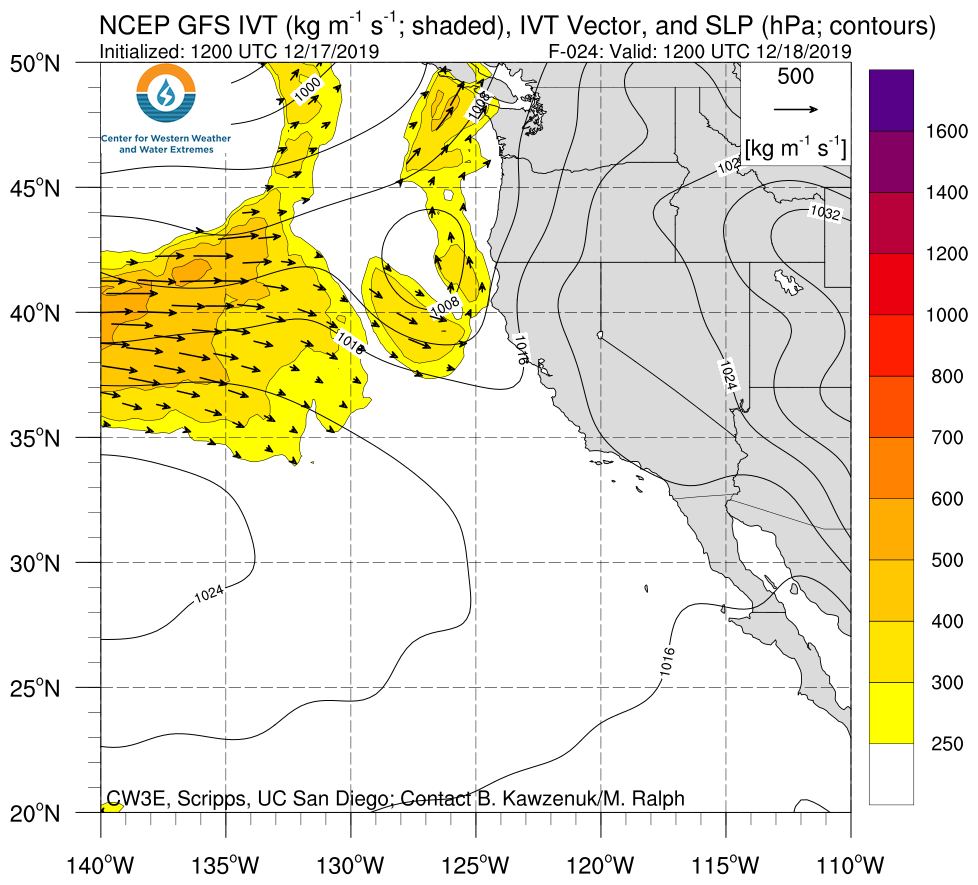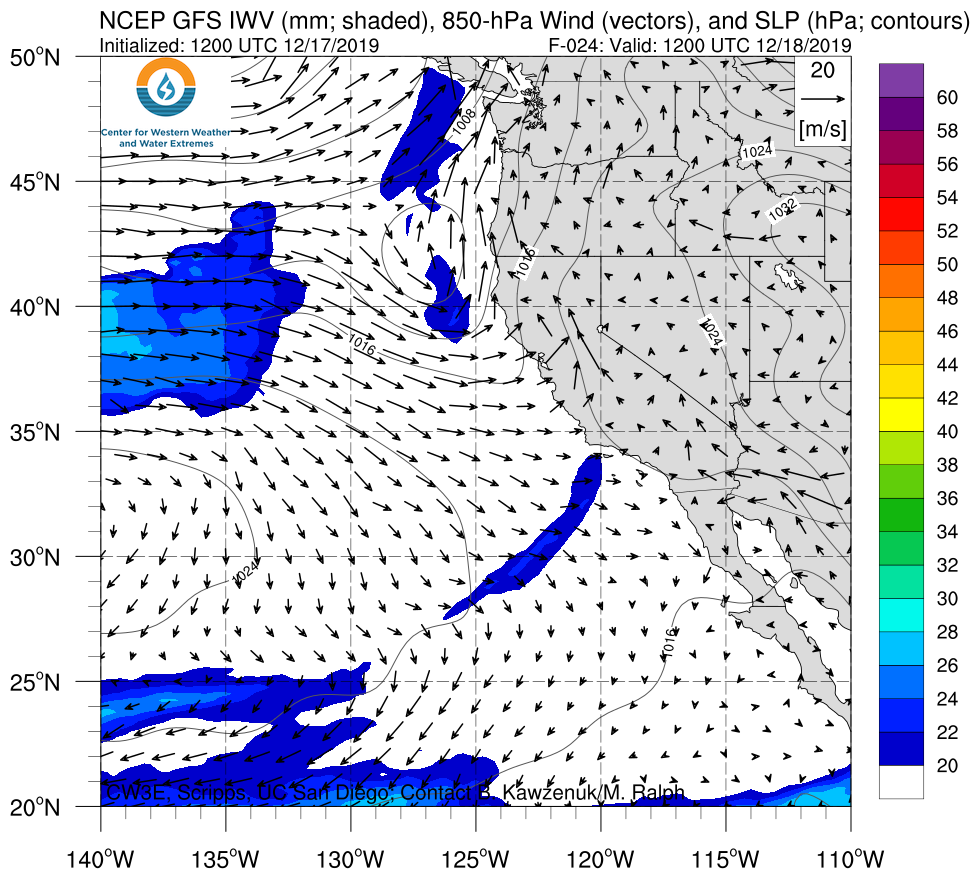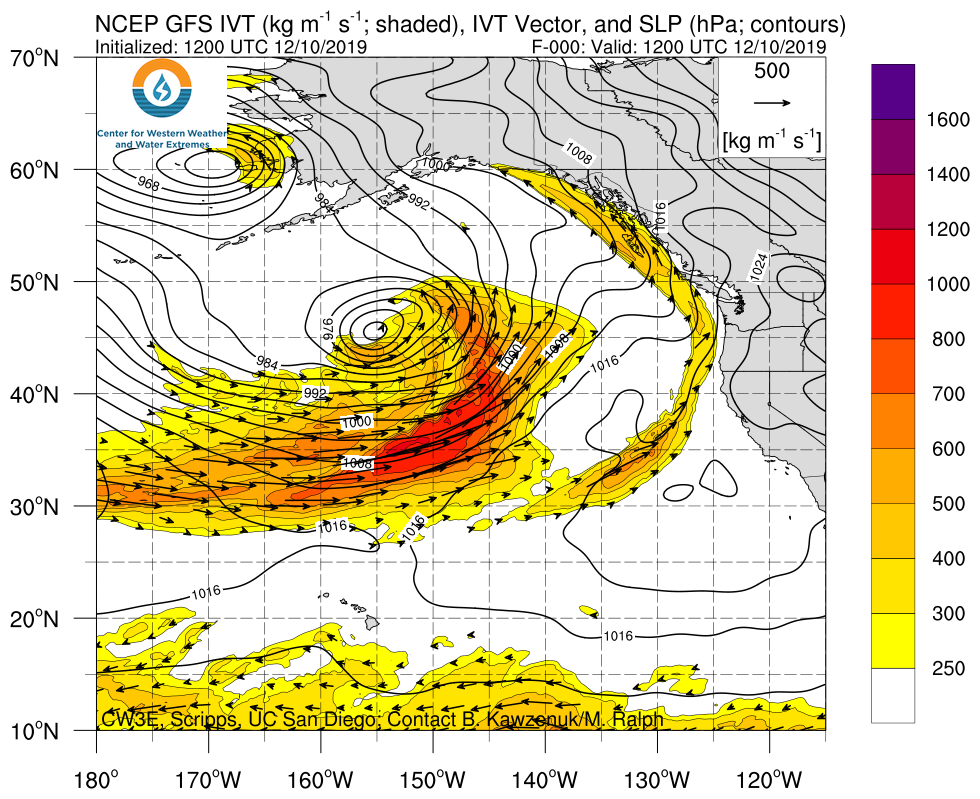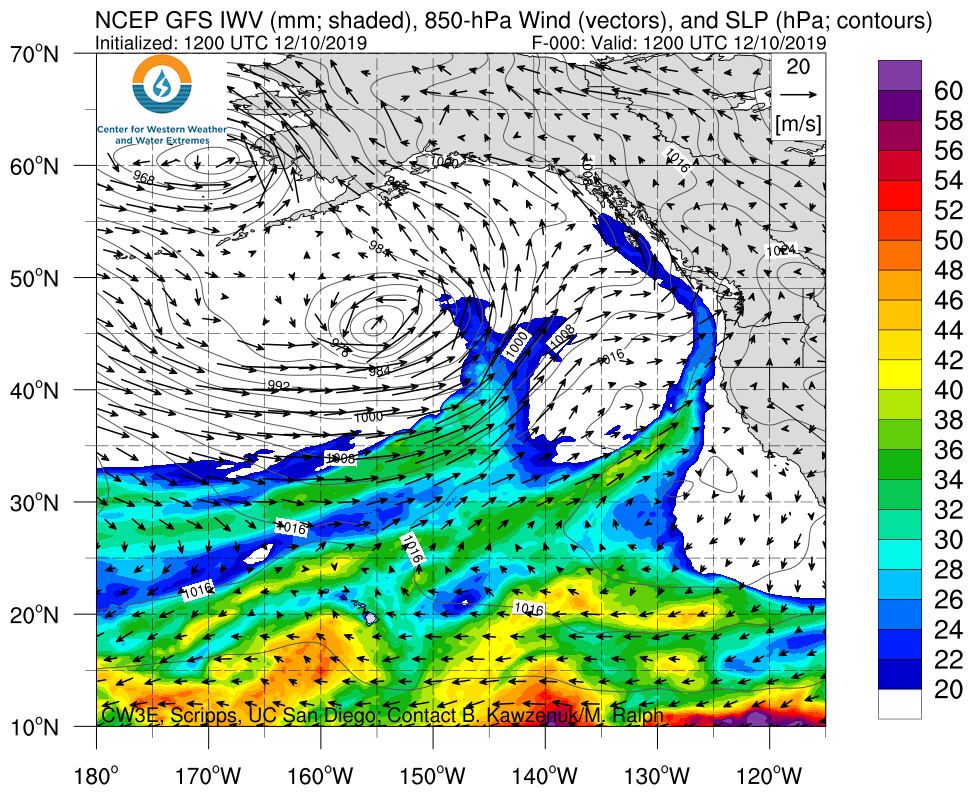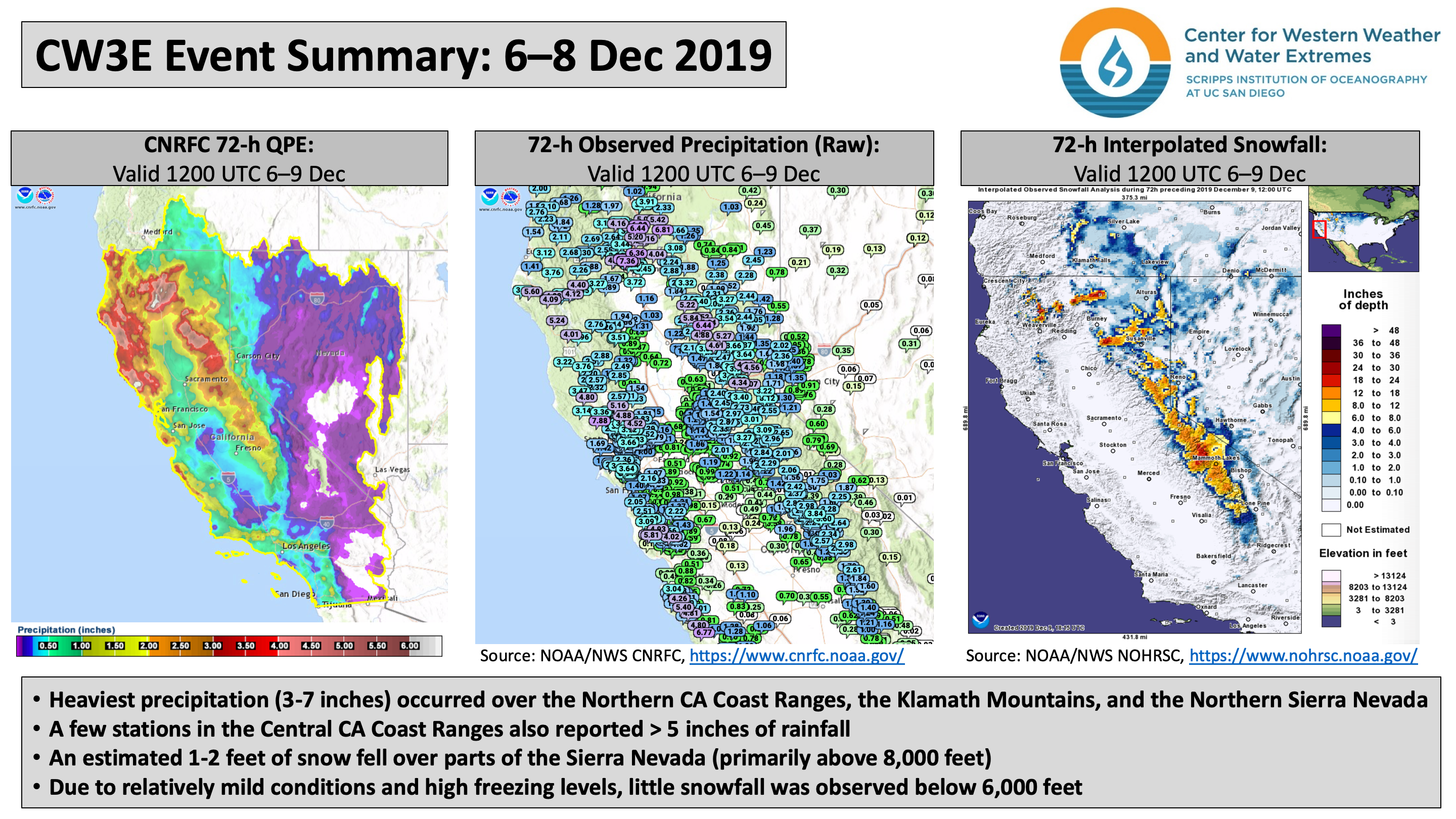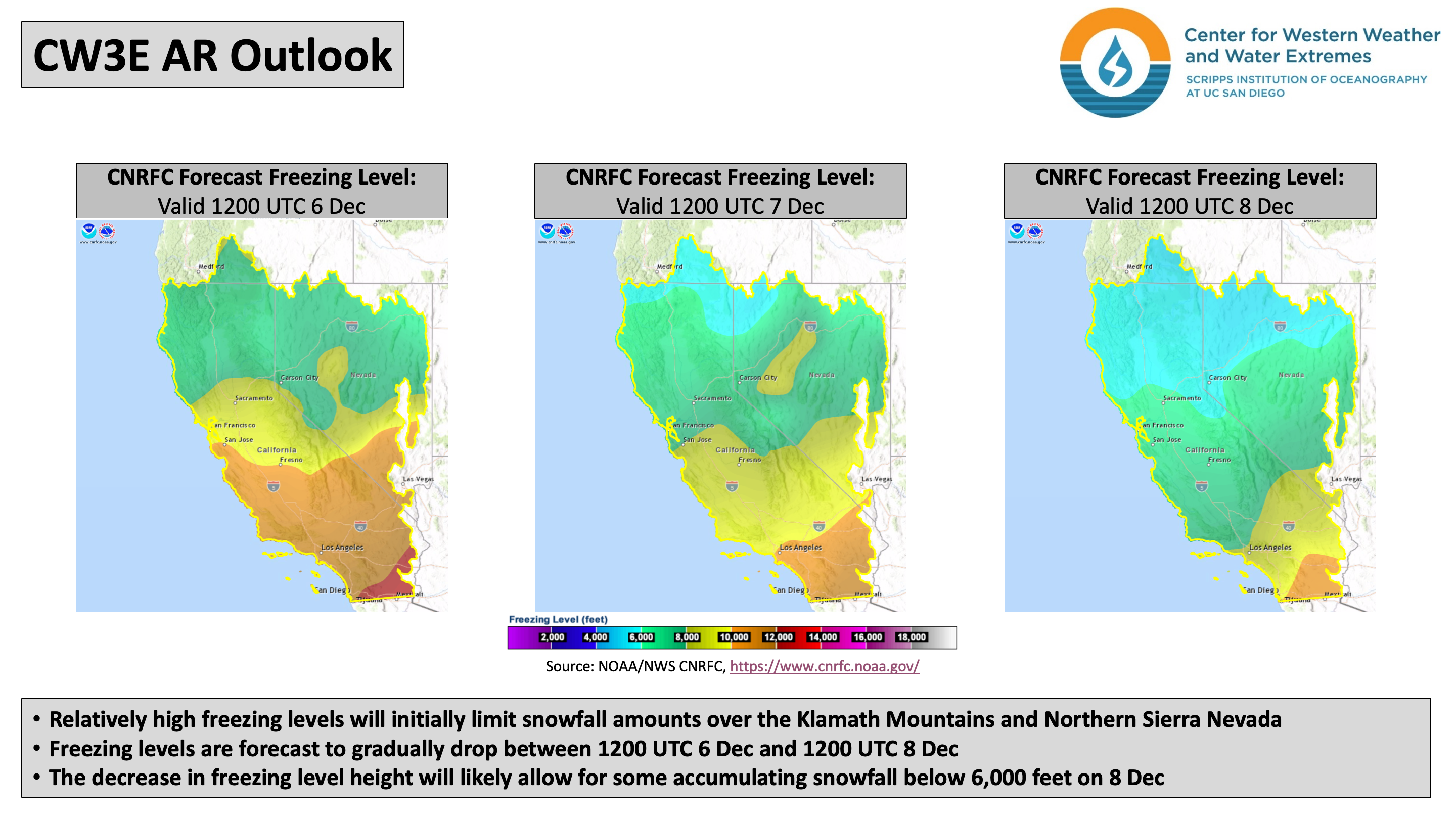CW3E at AGU 2019
December 18, 2019
CW3E participated in the recent 2019 American Geophysical Union Fall Meeting held in San Francisco, CA from 9-13 December. Graduate students, postdocs, and staff convened sessions, spoke, and presented posters. The list below covers CW3E personnel activities. Links include abstracts, as well as audio presentations (when available) and other supplementary materials.
Astitha M., L.D. Monache, and F. Cannon. A34C- Extreme Weather Events: Forecast Skill, Uncertainty Quantification, and Impact Modeling I
Astitha M., L.D. Monache, and F. Cannon. A31O – Extreme Weather Events: Forecast Skill, Uncertainty Quantification, and Impact Modeling II Posters
Ban Z., T. Das, D.R. Cayan, M. Xiao, and D.P. Lettenmaier. H23J-2036- Understanding the Role of Asymmetrical Warming on Streamflow Changes in the Western U.S. Using a Multi-model Approach
Brandt T., F. Cannon, J. Dozier. H33P-2239- Assessing WRF’s Seasonal Quantitative Precipitation Estimates (QPE) in California’s Sierra Nevada Using the Airborne Snow Observatory
Borsa A.A., S. Adusumilli, W. Neely, and F.M. Ralph. H33O-2228- Atmospheric river precipitation drives rapid terrestrial water storage variability in the western United States
Candido S., A. Singh, and L.D. Monache. A21O-2769- Distilling an Analog Ensemble into a Deep Neural Network
Cannon F., R.R. Weihs, L. Isaac, and L.D. Monache. H31D-07- An Ensemble-Based Evaluation of WRF Precipitation Forecast Uncertainty in California Watersheds
Cao B., J.S. Haase, M.J. Alexander, M. Bramberger, M.J. Murphy, and F.M. Ralph. SA23B-3127- Investigation of inertia gravity waves observed by dropsonde and airborne Radio Occultation during an Atmosphere River event in the northeast Pacific
Cao Q., M.J. Deflorio, F.M. Ralph, and D.P. Lettenmaier. H13F-03- Evaluation of the subseasonal forecast skill of AR-related flooding along the coastal Western U.S.
Cayan D. R., J.P. Goodrich, M. Buhler, and D. Dulen. GC44B-03 – Cold Air Pooling during Summer Heat Waves in California’s Sierra Nevada
Cifelli R., A.M. Wilson, A. Dufour, T.W. Parzybok, M.D. Dettinger, J.A. Vano, F. Munoz-Arriola, and K.A. Miller. PA34A-07- Toward Greater Resilient Water Infrastructure to Future Hydrometeorological and Climate Extremes: Lessons from Oroville Dam and Hurricane Harvey
Corringham T., F.M. Ralph, A. Gershunov, D.R. Cayan, and C.A. Talbot. H14G-06 – A scale of atmospheric river intensity captures the economic impacts of flooding in the western United States
Deflorio M., D.E. Waliser, F. M.Ralph, L.D. Monache, P. Gibson, B. Guan, A. Goodman, Z. Zhang, A. Gershunov, T. Shulgina, K. Guirguis, S. Asharaf, A. Subramanian, F. Vitart, H. Lin, and A. Kumar. H31G-04- Subseasonal-to-Seasonal (S2S) Prediction of Atmospheric Rivers and Precipitation over the Western United States
Delaney C., M. Konieczki, R. Hartman, J. Mendoza, J. Jasperse, F.M. Ralph, and C. Talbot. H13S-2031- A Risk-Based Decision Support System for Flood Operations of Lake Mendocino in Water Year 2019
Dettinger M.D., H14E-02- Drought Indicators for the Western US with Climate Change in Mind
Fish M.A., A.M. Wilson, J. Done, and F.M. Ralph. GC52A-01- Large-scale drivers of connected atmospheric rivers along the US West Coast
Gibson P.B., D.E. Waliser, B. Guan, M. DeFlorio, F.M. Ralph, and D.L. Swain. A24A-04- Ridging associated with drought across the Western United States: S2S predictability sources and model skill
Guan B., D.E. Waliser, and F.M. Ralph. A34F-04- Lightning Characteristics Associated with Atmospheric Rivers Affecting the Continental US Using the GOES-16/17 Geostationary Lightning Mappers
Harpold A.A., P.D. Brooks, M. Kohler, J. Sturtevant, B. Gordon, and M.D. Dettinger. H11J-1630- How Ready Is The Hydrologic Sciences For the Loss of Seasonal Snowpacks (And What Can Be Done)?
Katz L.J., A.A. Harpold, M.D. Dettinger, S.A. Drake, K.S. Jennings, and S. Rajagopal. H51P-1700- Catch or Release? Sensitivity of Extreme Rain-on-Snow Responses to Snowpack Mass and Energy Balances in California’s Northern Sierra Nevada, USA
Knowles N., D.R. Cayan, C. Cronkite-Ratcliff, M.D. Dettinger, A.L. Flint, L.E. Flint, T. Fregoso, J.J. Helly, B.E. Jaffe, H. Kernkamp, L.V. Lucas, R. Martyr-Koller, T. Morgan-King, D.W. Pierce, D. Roelvink, D.H. Schoellhamer, M.A. Stern, A. van Dam, S. van der Pijl, M. Van der Wegen, J. Vroom, and S.A. Wright. H52D-03- Climate-to-ecosystem integrated modeling in the San Francisco Bay-Delta estuary: An overview of the CASCaDE project (Part 1—Modeling of physical processes)
Lamjiri M.A., F.M. Ralph, and M.D. Dettinger. A43O-3034- Recent Changes in United States Extreme Precipitation as Indicated by Excursions on the R-CAT Scale
Mascioli N., A.T. Evan, and F.M. Ralph. A34B-05- Influence of dust on landfalling atmospheric rivers in an idealized framework
Nguyen P., E.J. Shearer, M. Ombadi, V.A. Gorooh, K. Hsu, S. Sorooshian, W.S. Logan IV, and F.M. Ralph. H22D-06PDIR- (PERSIANN Dynamic Infrared – Rain rate) model for high-resolution, real-time satellite precipitation estimation
Oakley N., F. Cannon, E. Boldt, J.L. Dumas, and F.M. Ralph. H11N-1708- Origins and Variability of Extreme Precipitation in the Santa Ynez River Basin of Southern California
Osborne T. C., J.R. Norris, A.M. Wilson, B. Henn, B. Hatchett, and F.M. Ralph. A53L-3074- Extreme Changes in Atmospheric Snow Level Observed by FM-CW Snow Level Radars During California Storms
Payne A.E., C.A. Shields, J.J. Rutz, L.R. Leung, T.A. O’Brien, F.M. Ralph, and M.F. Wehner. A41E-03- Atmospheric Rivers in a Changing Climate: An Overview from the Second Phase of the Atmospheric River Tracking Method Intercomparison Project (ARTMIP)
Pierce D.W. and D.R. Cayan. A51Q-2839- Downscaling IPCC Scenarios to the Hourly Level: Projected Changes in Energy Demand and Chill Hours in California
Reynolds C.A., R. Stone, J.D. Doyle, N.L. Baker, R. Langland, F.M. Ralph, D. Lavers, and P. Papin. A31M-2880- Experiments using Atmospheric River Reconnaissance Dropsondes
Ryoo J., S. Chiao, R.J. Spackman, L.T. Iraci, F.M. Ralph, A. Martin, J.E. Marrero, E.L Yates, R.M. Dole, T.V. Bui, J.M. Dean-Day, and C.S. Chang. A51O-2868- Formation of Terrain Trapped Airflows in Northern California during Atmospheric Rivers and its impact on Precipitation: A Case Study using Measurements and Model
Sturtevant J., M.D. Dettinger, S.A. McAfee, S. Rajagopal, and A.A. Harpold. H33P-2246- Improving Regression-Based Water Supply Forecasts following Snow Droughts in the Western U.S.
Sumargo E., R.R. Weihs, and A.M. Wilson. H51U-1803- Profiling of Soil Moisture Variability and Its Role in Rainfall-Runoff Generation in Northern California’s Russian River Watershed
Wilson, A.M. EP53D-16 – Rivers in the Sky – Why I Study the Earth’s Atmospheric Processes (Invited)
Wilson, A.M., F. M. Ralph, J. Jasperse, and C.A. Talbot. PA34B-11 – Exploring Novel Strategies to Enhance Use of Existing Water Management Infrastructure: Collecting Unique Observations with Local Partners (Invited)


